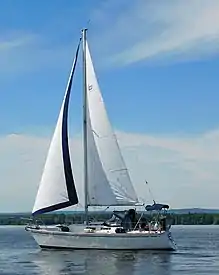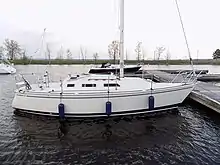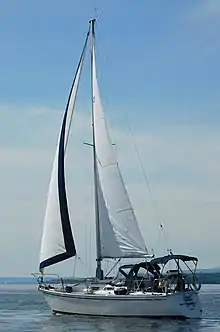Pearson 28
The Pearson 28 is a family of American sailboats, that were designed by William Shaw and first built in 1975.[1][2][3]
 | |
| Development | |
|---|---|
| Designer | William Shaw |
| Location | United States |
| Year | 1985 |
| Builder(s) | Pearson Yachts |
| Boat | |
| Boat weight | 7,000 lb (3,175 kg) |
| Hull | |
| Type | Monohull |
| Construction | Fiberglass |
| LOA | 28.46 ft (8.67 m) |
| LWL | 24.47 ft (7.46 m) |
| Beam | 9.83 ft (3.00 m) |
| Hull draft | 4.83 ft (1.47 m) |
| Engine type | Yanmar 2GM20 diesel engine |
| Hull appendages | |
| Keel/board type | fin keel |
| Ballast | 2,550 lb (1,157 kg) |
| Rudder(s) | internally-mounted spade-type rudder |
| Rig | |
| General | Masthead sloop |
| I (foretriangle height) | 37.50 ft (11.43 m) |
| J (foretriangle base) | 11.25 ft (3.43 m) |
| P (mainsail luff) | 31.92 ft (9.73 m) |
| E (mainsail foot) | 10.75 ft (3.28 m) |
| Sails | |
| Mainsail area | 171.57 sq ft (15.939 m2) |
| Jib/genoa area | 210.94 sq ft (19.597 m2) |
| Total sail area | 382.51 sq ft (35.536 m2) |
| Racing | |
| PHRF | 186 (average) |
The series was built by Pearson Yachts in the United States, but it is now out of production.[1]
Design
The Pearson 28 series are all small recreational keelboats, built predominantly of fiberglass, with a balsa cored deck and wood trim. They have masthead sloop rigs, internally-mounted spade-type rudders and fixed fin keels.[1][2]
Variants
- Pearson 28
- This model was introduced in 1975 and then updated in 1980 with a new keel and interior improvements and remained in production until 1982 in its modified form. It has a length overall of 28.00 ft (8.5 m), a waterline length of 25.00 ft (7.6 m), displaces 7,850 lb (3,561 kg) and carries 3,530 lb (1,601 kg) of lead ballast. The boat has a draft of 4.50 ft (1.37 m) and 5.00 ft (1.52 m) after the new keel was added in 1980. The early version also had an optional shoal draft keel. The boat is fitted with a Universal Atomic 4 gasoline engine of 30 hp (22 kW). The fuel tank holds 13 U.S. gallons (49 L; 11 imp gal) and the fresh water tank has a capacity of 22 U.S. gallons (83 L; 18 imp gal). The boat has a hull speed of 6.56 kn (12.15 km/h).[1][2][4][5][6]
- Pearson 28-2
- This all-newly designed model was introduced in 1985 and produced until 1989. It has a length overall of 28.46 ft (8.7 m), a waterline length of 24.47 ft (7.5 m), displaces 7,000 lb (3,175 kg) and carries 2,550 lb (1,157 kg) of lead ballast. The boat has a draft of 4.83 ft (1.47 m) with the standard keel. An optional shoal draft keel was also available, with a draft of 3.50 ft (1.07 m). The boat is fitted with a Japanese Yanmar 2GM20 diesel engine. The fuel tank holds 18 U.S. gallons (68 L; 15 imp gal) and the fresh water tank has a capacity of 25 U.S. gallons (95 L; 21 imp gal). The boat has a PHRF racing average handicap of 186 with a high of 192 and low of 180. It has a hull speed of 6.63 kn (12.28 km/h).[7][8][9]

Pearson 28-2

Pearson 28-2
See also
Related development
Similar sailboats
References
- Browning, Randy (2017). "Pearson 28 (1975-80) sailboat specifications and details". sailboatdata.com. Retrieved 5 June 2017.
- InterVisionSoft LLC (2017). "Sailboat Specifications for 1977-80 Pearson 28". Sailing Joy. Retrieved 5 June 2017.
- Browning, Randy (2017). "William Shaw 1926-2006". sailboatdata.com. Retrieved 5 June 2017.
- Browning, Randy (2017). "Pearson 28 (1980-82) sailboat specifications and details". sailboatdata.com. Retrieved 5 June 2017.
- InterVisionSoft LLC (2017). "Sailboat Specifications for 1980-82 Pearson 28". Sailing Joy. Retrieved 5 June 2017.
- InterVisionSoft LLC (2017). "Sailboat Specifications for 1977-80 Pearson 28 SD". Sailing Joy. Retrieved 5 June 2017.
- Browning, Randy (2017). "Pearson 28-2 sailboat specifications and details". sailboatdata.com. Retrieved 5 June 2017.
- InterVisionSoft LLC (2017). "Sailboat Specifications for 1985 Pearson 28-2". Sailing Joy. Retrieved 5 June 2017.
- InterVisionSoft LLC (2017). "Sailboat Specifications for 1985 Pearson 28-2 SD". Sailing Joy. Retrieved 5 June 2017.
External links
 Media related to Pearson 28 at Wikimedia Commons
Media related to Pearson 28 at Wikimedia Commons
This article is issued from Wikipedia. The text is licensed under Creative Commons - Attribution - Sharealike. Additional terms may apply for the media files.